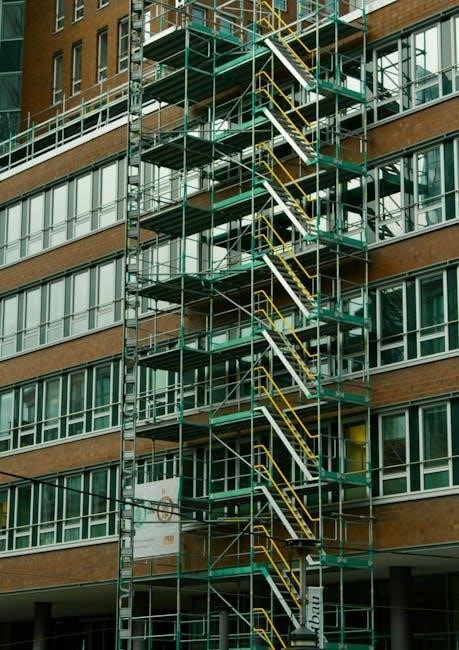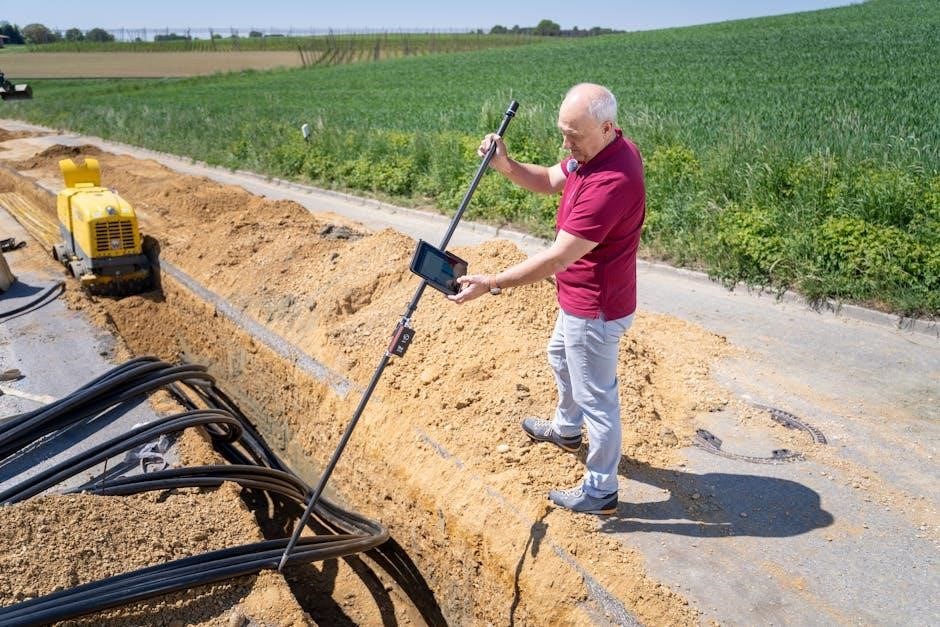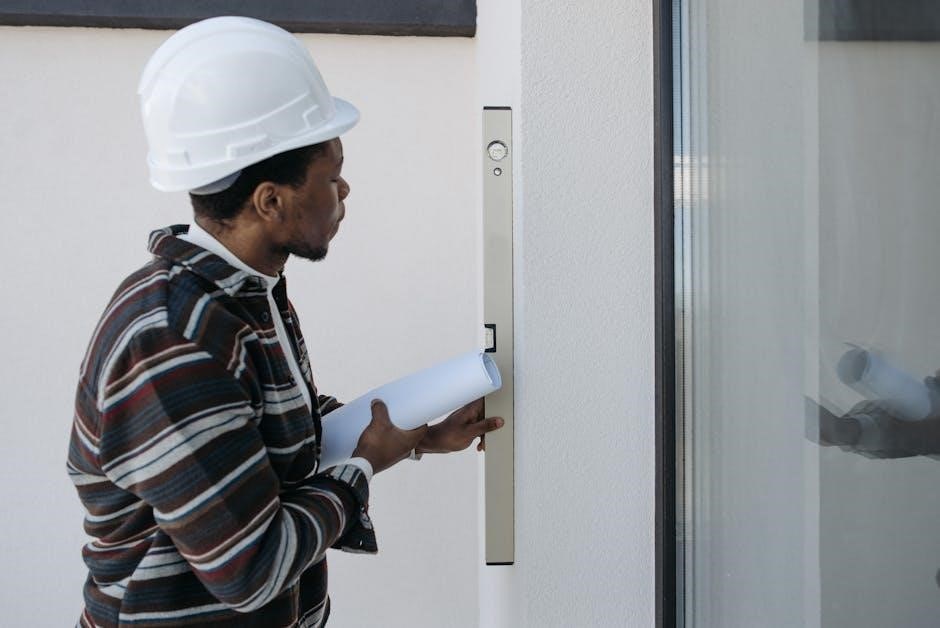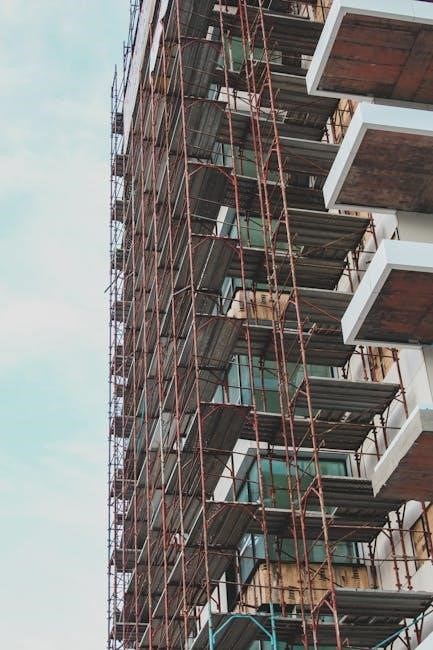
A construction site safety plan ensures a safe working environment, minimizing risks and complying with regulations․ It outlines protocols, responsibilities, and hazard controls, essential for protecting workers and assets․ Customizable PDF templates are available for easy implementation and compliance with safety standards․

1․1 Importance of Safety in Construction Sites
Safety is paramount in construction sites due to the high-risk nature of activities involving heavy machinery, heights, and hazardous materials․ Ensuring safety protects workers from injuries, reduces project delays, and prevents legal liabilities․ A well-implemented safety plan fosters a culture of awareness and responsibility, minimizing accidents and enhancing overall productivity․ Compliance with regulations like OSHA standards is crucial, and a structured approach ensures adherence to these guidelines․ By prioritizing safety, construction sites can create a secure environment for all personnel, contractors, and visitors, ultimately contributing to successful project outcomes and maintaining a positive industry reputation․ A construction site safety plan PDF provides a clear, accessible framework for achieving these goals effectively․
1․2 Overview of a Construction Site Safety Plan
A construction site safety plan is a comprehensive document outlining strategies to ensure a safe working environment․ It includes hazard identification, risk assessments, and control measures to mitigate potential dangers․ The plan also details safety protocols, emergency response procedures, and the roles of all personnel involved․ Compliance with regulatory standards, such as OSHA, is a key component․ Customizable PDF templates are widely used to create site-specific plans, addressing unique project risks․ Regular updates and reviews ensure the plan remains relevant as site conditions evolve․ By providing clear guidelines and expectations, a safety plan promotes accountability and collaboration among workers, contractors, and management, ultimately reducing incidents and ensuring project success․

Purpose and Scope of the Safety Plan
The purpose of a construction site safety plan is to ensure a safe environment, minimize risks, and comply with regulations․ Its scope covers all site activities, hazard identification, and control measures․
2․1 Defining the Purpose of the Safety Plan
The purpose of a construction site safety plan is to establish a structured approach to ensuring the safety and health of all personnel on site․ It outlines the measures to identify, assess, and mitigate risks, ensuring compliance with OSHA and other regulatory standards․ The plan serves as a guide for safe work practices, emergency procedures, and incident reporting․ It also defines roles and responsibilities, promoting accountability and collaboration among workers, contractors, and management․ By addressing specific hazards and implementing control measures, the safety plan aims to prevent incidents, protect assets, and maintain a productive work environment․ It is a dynamic document that adapts to site conditions, ensuring continuous improvement in safety practices and regulatory compliance․

2․2 Scope of the Safety Plan
The scope of a construction site safety plan defines the specific areas and activities it covers to ensure a safe working environment․ It applies to all personnel, including employees, contractors, and visitors, and addresses site-specific hazards, such as equipment operations, fall risks, and chemical exposure․ The plan outlines the safety protocols for pre-construction, ongoing operations, and post-construction phases․ It also ensures compliance with OSHA standards and other regulatory requirements․ The scope may include emergency response procedures, incident reporting, and training requirements; By clearly defining the boundaries and application of the safety plan, it ensures that all risks are identified and managed effectively, promoting a culture of safety and accountability across the construction site․
2․3 Roles and Responsibilities
The construction site safety plan clearly outlines the roles and responsibilities of all parties involved to ensure a safe working environment․ Project managers are responsible for overseeing safety compliance and coordinating safety planning․ Safety officers develop and implement training programs, conduct inspections, and enforce safety protocols․ Contractors and subcontractors must adhere to the safety plan and report hazards․ Employees are expected to follow safety procedures, use PPE, and participate in training․ Supervisors ensure compliance and address safety concerns promptly․ Visitors and clients must comply with site-specific safety rules․ By defining these roles, the plan promotes accountability and ensures that safety is a shared responsibility, minimizing risks and fostering a culture of safety across the construction site․

Hazard Identification and Risk Assessment
Hazard identification involves recognizing potential dangers on site, such as equipment malfunctions or falls․ Risk assessment evaluates the likelihood and impact of these hazards, enabling prioritized control measures․
3․1 Common Hazards in Construction Sites
Construction sites are prone to various hazards, including falls from heights, equipment malfunctions, and struck-by incidents․ Other risks include electrical shocks, trench collapses, and chemical exposures․ Proper safety measures, such as fall protection systems, regular equipment maintenance, and electrical safety protocols, are essential to mitigate these dangers․ Additionally, hazards like uneven terrain, poor lighting, and inclement weather can exacerbate risks․ A comprehensive safety plan must address these common hazards through specific controls and training to ensure worker safety and compliance with regulations․ By identifying and managing these risks, construction sites can reduce accidents and create a safer working environment for all personnel․
3․2 Risk Assessment Process
The risk assessment process is a systematic approach to identifying, evaluating, and controlling hazards on construction sites․ It begins with hazard identification, where potential risks such as equipment, falls, and chemicals are recognized․ Next, the risk level is analyzed based on severity and likelihood․ Prioritization ensures the most critical risks are addressed first․ Control measures, such as engineering solutions or PPE, are then implemented to mitigate these risks․ Documentation of the assessment is essential for compliance and accountability․ Regular monitoring and reviews ensure the effectiveness of controls and adapt to changing site conditions․ This process is crucial for ensuring a safe working environment and compliance with safety regulations․
3․3 Hazard Control Measures
Hazard control measures are essential to minimize risks and ensure a safe construction site․ These measures include engineering controls, such as guardrails and safety nets, to eliminate or reduce hazards․ Personal Protective Equipment (PPE) like hard hats, gloves, and respirators is also critical․ Administrative controls, such as safety training and procedures, help manage risks through proper protocols․ Regular equipment maintenance and inspections further prevent accidents․ Fire safety measures, including fire extinguishers and emergency plans, are also vital․ Documentation of these controls ensures compliance with safety standards․ By implementing these measures, construction sites can significantly reduce incidents and protect workers․ Continuous monitoring and updates to controls adapt to changing site conditions, ensuring ongoing safety․
Safety Protocols and Procedures
Safety protocols and procedures are essential for preventing incidents․ They include PPE requirements, equipment maintenance, fire safety measures, fall protection, and emergency response plans․ Regular inspections ensure compliance․
4․1 Personal Protective Equipment (PPE) Requirements
Personal Protective Equipment (PPE) is critical for safeguarding workers from construction site hazards․ Hard hats, safety glasses, respirators, and high-visibility clothing are essential․ Steel-toe boots protect against heavy objects, while gloves prevent cuts and abrasions․ PPE must meet industry standards and be worn as specified in the safety plan․ Employers are responsible for providing suitable equipment and ensuring proper use․ Regular inspections and maintenance of PPE are mandatory to guarantee effectiveness․ Training on PPE selection, use, and care is required for all personnel․ Compliance with PPE requirements minimizes injury risks and ensures a safer working environment․ Proper documentation of PPE issuance and training is maintained for regulatory compliance and accountability․
4․2 Equipment Safety and Maintenance
Equipment safety and maintenance are vital to preventing accidents and ensuring operational efficiency on construction sites․ Regular inspections and preventive maintenance schedules must be implemented to identify and address potential hazards․ All machinery and tools should be operated by trained personnel, adhering to manufacturer guidelines․ Proper lubrication, replacement of worn parts, and timely repairs are essential to maintain equipment functionality․ Operators must report any malfunctions or safety concerns immediately․ A documented maintenance record should be kept for compliance and accountability․ Additionally, equipment should be stored securely when not in use to prevent unauthorized access or damage․ Proper maintenance not only extends equipment lifespan but also reduces the risk of accidents, ensuring a safer working environment for all personnel․ Regular audits and updates to maintenance protocols are crucial for sustained safety and efficiency․

4․3 Fire Safety Measures
Fire safety measures are critical to preventing and managing fire-related hazards on construction sites․ All sites must have accessible fire extinguishers, with types suited to potential fire risks․ Emergency evacuation routes should be clearly marked and unobstructed․ Regular fire safety training is essential for all personnel to understand evacuation procedures and proper extinguisher use․ Flammable materials must be stored safely, away from ignition sources․ Smoking should be restricted to designated areas, and hot work permits must be obtained for activities like welding or cutting․ Fire alarms and detection systems should be installed and tested regularly․ A fire safety plan should outline procedures for emergencies, including evacuation protocols and communication methods․ Regular fire drills and inspections ensure preparedness and compliance with safety regulations, minimizing risks and protecting lives and property․

4․4 Fall Protection and Prevention
Fall protection and prevention are critical components of construction site safety plans․ Guardrails, safety nets, and personal fall arrest systems (PFAS) are essential for preventing falls from heights․ Workers must be trained to identify fall hazards and use equipment properly․ Hard hats and harnesses should be inspected regularly to ensure reliability․ Scaffolding and ladders must meet safety standards, and unstable surfaces should be secured․ Safety nets or catch platforms can provide additional protection for high-risk areas․ Regular inspections of fall protection equipment and systems are mandatory to ensure compliance with OSHA standards․ Employers must enforce fall prevention measures and provide ongoing training to reduce the risk of accidents․ Proper planning and equipment maintenance are key to safeguarding workers from fall-related injuries․
Emergency Response Plan
An effective emergency response plan ensures prompt actions during incidents, including evacuation routes, first aid, and incident reporting․ Clear communication protocols and regular drills are essential for preparedness and safety․
5․1 Emergency Procedures and Evacuation Routes
Effective emergency procedures and evacuation routes are critical for ensuring safety during construction site incidents․ These plans must be clearly outlined in the construction site safety plan PDF, detailing step-by-step actions for emergencies like fires, equipment failures, or medical crises․ Evacuation routes should be well-marked, accessible, and communicated to all personnel․ Regular drills and training ensure that workers understand the procedures and can act swiftly․ The plan should also include designated assembly points for headcounts and coordination with emergency services․ Clear signage and illuminated pathways enhance visibility, while communication devices ensure real-time updates․ Documentation of evacuation plans and drills is essential for compliance and continuous improvement․ A well-organized emergency response system minimizes risks and protects lives, making it a cornerstone of any comprehensive safety plan․
5․2 First Aid and Medical Emergency Response
First aid and medical emergency response are vital components of a construction site safety plan PDF․ The plan must outline the location of first aid kits, the availability of trained personnel, and procedures for responding to medical emergencies․ All workers should know the location of first aid stations and how to summon medical assistance quickly․ Emergency response protocols should include procedures for injuries, such as burns, fractures, or cardiac incidents․ Communication devices must be accessible to contact emergency services promptly․ The plan should also detail the process for transporting injured workers to medical facilities․ Regular training and drills ensure that the workforce is prepared to handle medical emergencies effectively․ Documentation of incidents and responses is essential for compliance and continuous improvement․ A well-organized first aid and medical response system ensures timely care, reducing the risk of severe outcomes and promoting worker well-being․

5․3 Incident Reporting and Documentation
Incident reporting and documentation are critical for maintaining safety and accountability on construction sites․ A construction site safety plan PDF must include detailed procedures for reporting incidents, such as injuries, near-misses, or equipment damage․ All incidents should be documented promptly, with accurate details about what happened, who was involved, and the root cause․ Supervisors and safety officers must ensure that incident reports are completed and reviewed thoroughly․ Documentation should also include corrective actions taken to prevent future occurrences․ Proper record-keeping helps comply with legal requirements and improves overall site safety․ Regular audits of incident reports can identify trends and areas for improvement․ Using standardized templates ensures consistency in reporting and simplifies the process for workers․ Timely and accurate documentation is essential for learning from incidents and enhancing workplace safety․

Legal and Regulatory Compliance
A construction site safety plan must ensure adherence to OSHA standards and environmental regulations․ Proper documentation and record-keeping are essential for compliance, with regular audits to verify adherence to legal requirements․

6․1 OSHA Standards and Regulations
OSHA (Occupational Safety and Health Administration) standards are critical for ensuring workplace safety in construction․ A construction site safety plan must comply with OSHA regulations, including fall protection, scaffolding, and personal protective equipment (PPE) requirements․ Regular inspections and training programs are essential to maintain compliance․ Employers must document adherence to OSHA standards, such as hazard communication and respiratory protection․ Non-compliance can result in penalties and increased risks of accidents․ By integrating OSHA guidelines into the safety plan, construction sites can reduce injuries and ensure a safe working environment․ Proper implementation of these standards is a legal and ethical responsibility for all stakeholders involved in the project․
6․2 Environmental Safety Regulations
Environmental safety regulations are essential for minimizing the ecological impact of construction activities․ A construction site safety plan must address waste management, pollution control, and the protection of natural resources․ Proper disposal of hazardous materials, such as chemicals and asbestos, is mandatory․ Spill prevention and stormwater management plans are also critical to prevent environmental contamination․ Compliance with local, state, and federal environmental laws ensures sustainable practices and avoids legal penalties․ Regular monitoring and reporting are required to maintain adherence to these regulations․ Environmental safety officers play a key role in enforcing these standards and conducting audits․ By integrating environmental safety into the safety plan, construction sites can reduce their ecological footprint while ensuring a safe working environment for all personnel․
6․3 Record-Keeping and Compliance Monitoring
Accurate record-keeping and compliance monitoring are critical components of a construction site safety plan․ This involves maintaining detailed documentation of safety inspections, incident reports, and training records․ Regular audits ensure adherence to safety protocols and regulatory requirements․ Digital tools and templates can streamline record-keeping, making it easier to track compliance․ Proper documentation also supports incident investigations and legal compliance․ Monitoring compliance involves periodic reviews of safety practices and corrective actions for any deviations․ Training records must be updated to reflect ongoing education and certifications․ By maintaining thorough records, construction sites can demonstrate their commitment to safety and regulatory adherence, reducing liability and improving overall safety performance․ Consistent monitoring ensures sustained compliance and continuous improvement in safety standards․